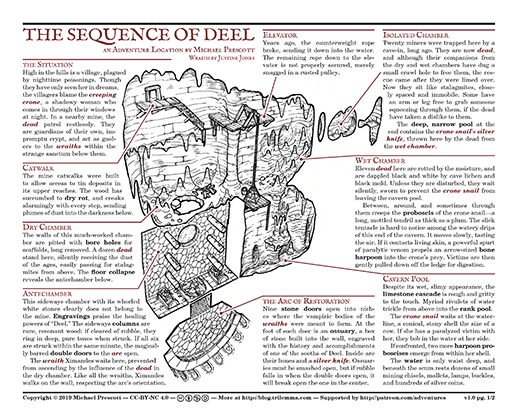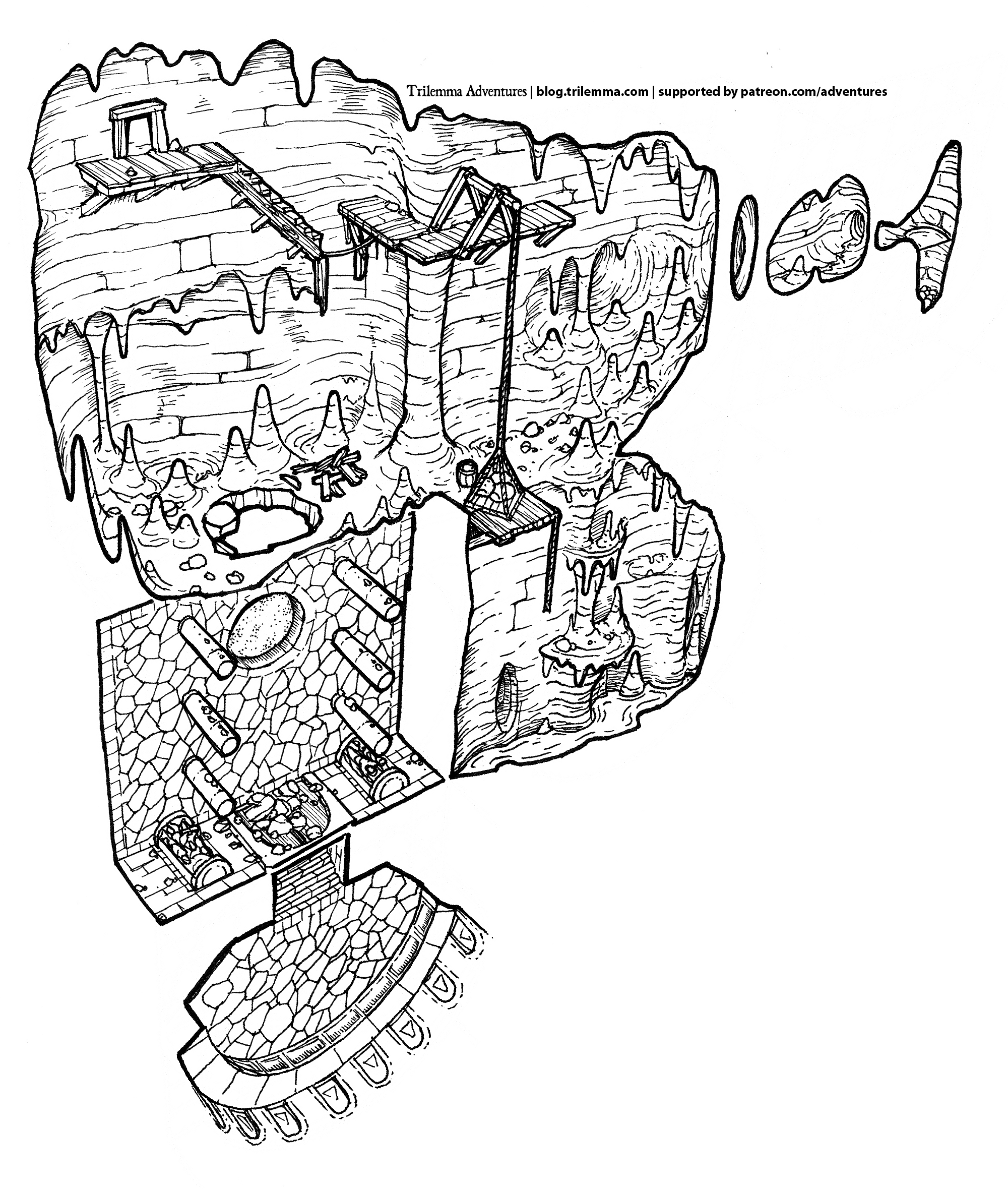This blog post is compatible with Dungeons & Dragons™ fifth edition. :)
* * *
I'm now in the world of feeling my way through creating various system-specific versions of the Trilemma bestiary, en route to publishing them.
My thought at this point is that there is a lot of murky thinking about what you can and can't publish, and this murkiness is a) deliberately created, and b) mostly helps the big players, like WOTC.
I'm not a lawyer, but this is what I've been able to piece together.
1. Large IP holders want you to believe that their official programs are the only way to produce compatible products
If you want to make a D&D-compatible product, prevailing wisdom is that you have two choices: use the OGL, or use the DMs Guild. (Why is there no apostrophe in that?)
I can understand
why the WOTCs of the world would want you to think this. People have a very hazy grasp on copyright law and trademark law, and if they just used their intuition all sorts of IP violations would occur. There's a very common idea, for example, that derivative works are fine to create and publish if you're not making money on them. (They're not.)
Official programs are a way of being really clear about what the IP holder is willing to allow people to do.
2. Licensing agreements describe an exchange
Licensing agreements give you something in exchange for something. For example, if you look at
Paizo's compatibility license, it describes an exchange between you and Paizo:
- You can use Paizo's trademarked "Pathfinder compatible" logo, and the associated font in your products
- Paizo gets your agreement that you'll only make 2e-compatible stuff, they get a copy of compatible products from you, and you agree not to refer to page numbers in their books.
Both of these things are new rights that each party didn't have previously. You didn't previously have permission to use Pathfinder's trademarked logo, and (of course) Paizo can't prevent random people from referring to Paizo page numbers.
Briefly, I've noticed a few things are common in licensing agreements:
- You're given permission to use copyrighted text (as in the OGL)
- You're given permission to use trademark logos
- You're given permission to use trade dress, fonts, or stylings
The D&D 5e SRD, for example, is licensed under the OGL (which grants permission to use copyrighted text) because they expect people to take chunks of that text and use it their publications. It gives the new right to republish copyrighted material.
3. Creating a licensing program doesn't remove any rights that you already had
This seems like a straight forward idea, but it's worth dwelling on.
Let's say WOTC created a new program called the Reviewing Wizards program. By agreeing to their license, you're allowed to call yourself a Review Wizard™ and use a special little -(RW)- logo when you do so, and in return you agree never to publish a negative review of a WOTC product. Fine.
Is this the only circumstances that you're allowed to publish reviews of WOTC products? No, of course not! WOTC creating this program doesn't suddenly give them control over all negative reviews. It only applies to participants in the Reviewing Wizards program.
If I'm publishing negative reviews of WOTC products, I can't use the Review Wizard™ trademark, because I didn't license it, but if I
don't join that program and take the
new rights it grants me, I don't have to abide by its restrictions. I can still do what I could do before.
So..
what can I do without permission?
4. Fair use of trademarks
Before I get into that, there's a difference between
compatibility and
statements about compatibility:
- A book with 5e stats in it is (in a lay sense) compatible (usable) with 5e.
- A book that says it's "compatible with Dungeons & Dragons™" on the cover is using a WOTC trademark to describe itself.
These are independent things. Okay, back to trademarks.
The International Trademark Association's page on the
fair use of trademarks is fascinating, because you can actually do quite a lot more than you might expect. The examples are useful, because there's a whole bunch of, "Oh yeah.." recognition moments. Think of:
- Third-party replacement blades for Gillette™ razors
- Repair shops that advertise being able to fix BMW™ cars
- Third-party sellers of iPhone™ 6 phone cases or chargers
- Unofficial guides to AAA video games
All of these are services or products that are compatible, but which also use another company's trademarked terms to describe themselves.
* * *
Why does all this matter? Frankly, because some of the popular licensing programs out there are batshit insane. So now, let me put on my Review Wizard™ hat and review some licensing programs.
Legal Lunacy: OBS Community Programs
The DMs Guild (why is there no apostrophe?) was the template for a number of OBS (DriveThruRPG)
community content programs, and to use them, you give up some remarkable things:
- You can never publish the work anywhere else—not in print, not via Kickstarter, not on itch.io, not on your blog, not anywhere. If they delist your product or the whole community content program shuts down, your content is then simply unpublishable.
- You can't publish works derived from it anywhere else, either.
- The publisher gets a permanent, irrevocable right to republish your work, including creating and selling derivative works. They can translate it, slice and dice it and put it in compilations, without paying you a dime or even telling you.
- OBS can sign legal documents on your behalf, operating as your 'attorney-in-fact' if they need new contracts to clarify or affirm their rights, as they see them.
That last one is so mind-bendingly overreaching that it's comical. You're giving them permission to negotiate for you, with themselves. It's like the devil wrote it.
As far as I can tell, the only reason to use this is if you're so smitten by the D&D brand that you want to rub that cachet on yourself, and/or blow hundreds of hours of hard work on a desperate notice me sempai play.
If you're going to market the hell out of your product (or cash in on your good name), then it makes a kind of sense: the median DMs Guild product makes 10% more revenue than the median DriveThruRPG product (sales are higher, but the WOTC clawback is almost aggressive enough to make up for it), but at the cost of giving away all rights that matter.
Alternately, if you have no marketing impulse whatsoever all and 50 sales sounds good to you, then these programs makes a kind of sense because at least you can play with WOTC IP while you're doing it.
For non-WOTC publishers who are too small to boost your sales or give you much IP to play with, I can't fathom why you'd touch an OBS community content program. This is the infectious green slime of licensing programs.
OGL
This is a funny one. As far as I can tell, the only reason you need to use the OGL is to republish OGC content. If your content is all new, there's no need to use the OGL whatsoever—in fact, you're explicitly giving up some fair use rights unnecessarily, since the OGL prohibits you from using Product Identity trademarks to declare compatibility.
In other words, if you reuse 5e SRD to make a 5E-compatible product, you're explicitly giving up the right to say it's D&D compatible.
If you're not actually republishing someone's OGC material, using the OGL looks like you've given up some rights for nothing.
Pathfinder Compatibility
In contrast, this actually looks pretty reasonable. You're forced to use the Paizo OGL, but the compatibility license gets rid of OGL's major restriction on the fair use of trademarks for compatibility statements, by letting you use their Paizo Compatible™ logo.
Also, it should be worth mentioning that Paizo doesn't take a cut. They haven't created a garden prison like WOTC, they just want to make sure that people are writing for the latest edition of Pathfinder.
* * *
D&D™ Compatible
In conclusion, contrary to popular wisdom, D&D™-compatible products which say, Compatible with D&D™ on the cover seem to be completely legal. As long as:
- You're not using any WOTC-copyrighted content that would require you to use the OGL
- You use the trade marks in a minimal way (e.g. no giant logo reuse, just naming them)
- No brand confusion is created, and no business relationship or endorsement is implied
Pay To Win
The sad fact is that, despite all this, having a heavyweight legal team lets you send scary-sounding cease-and-desist letters, and fighting them is too stressful and expensive for little publishers. Most (all?) of the fair use of trademarks examples I cited above were established by litigation, which is horrendously expensive.
One depressing but useful benefit of participating in an official license scheme is as a declaration of what the publisher won't try to bully you for doing.


